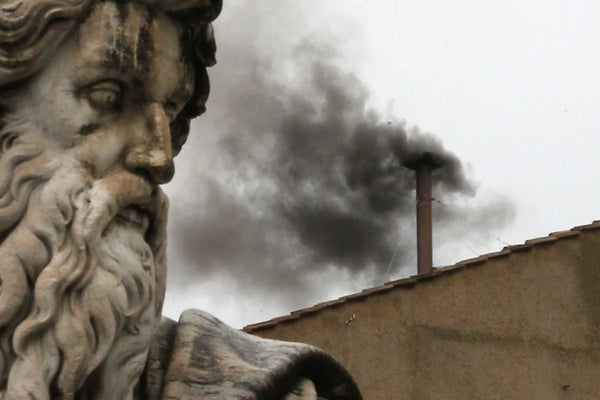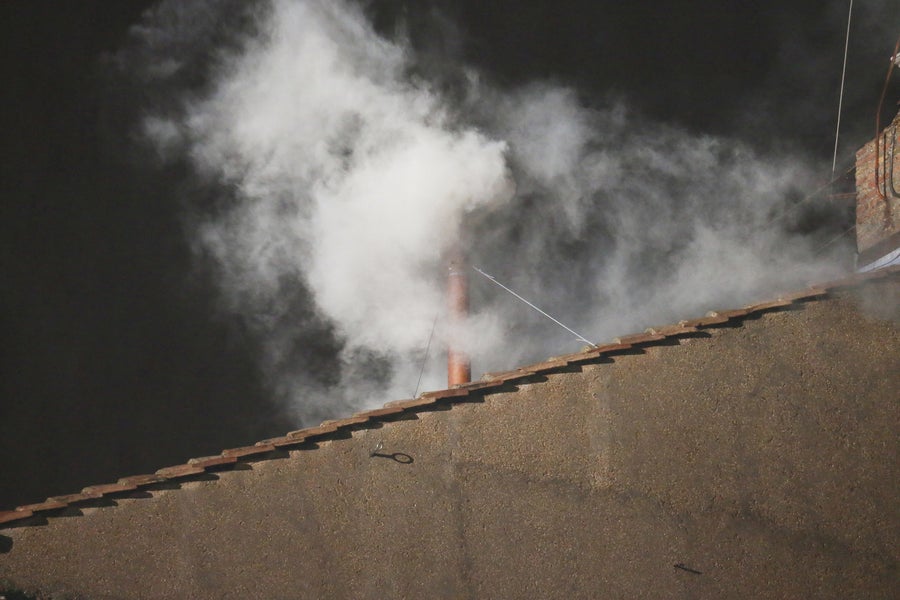The Pyrotechnic Chemistry of the Vatican’s Pope Smoke Signals Explained
Pyrotechnic chemistry drives the Vatican’s recipes for the black and white smoke used to announce papal election outcomes

Black smoke billows from the chimney on the roof of the Sistine Chapel indicating that the College of Cardinals have failed to elect a new Pope on March 13, 2013 in Vatican City, Vatican.
The Vatican’s cardinals gather in conclave today to begin electing the successor to the late Pope Francis—which means the world’s attention is on a chimney attached to the Sistine Chapel. Here puffs of black smoke mark voting rounds that fail to converge on a winner until the cardinals announce that they have come to an agreement by releasing a plume of white smoke, the dramatic prelude to the unveiling of the new leader of the Roman Catholic world.
Although the ritual may feel like something from another era, the papal conclave’s colored smoke signals only came into use in 1903, according to NBC News—a relatively recent development for a process that’s been going on for nearly a millennium. Historically, the signals have sometimes been ambiguous, but for recent elections, the Vatican has clearly consulted with scientific experts to ensure the Sistine Chapel’s chimney announces a clear verdict. Around the time of the 2013 conclave that elected Pope Francis, the Vatican published the ingredients of each smoke mix. (The Holy See Press Office did not respond to requests for confirmation that the same recipes remain in use this year.) Here’s the chemistry behind the conclave’s smoke announcements.
On supporting science journalism
If you’re enjoying this article, consider supporting our award-winning journalism by subscribing. By purchasing a subscription you are helping to ensure the future of impactful stories about the discoveries and ideas shaping our world today.
For chemists, “where there’s smoke, there’s fire” refers to combustion. In combustion reactions, a fuel reacts with an oxygen-rich substance called an oxidizer, creating waste products that often include water and carbon dioxide.
But the Vatican’s focus is the smoke, rather than the combustion that creates it. Smoke is made up of small particles suspended in air, says John Steinberg, a pyrotechnics expert. The smoke’s color is dictated by the particle color, which means white and black colored smoke result from waste products other than carbon dioxide, which is colorless. “You don’t want complete combustion because if we burn carbon completely, we get carbon dioxide,” he says.
The solution, Steinberg explains, is to stop the reaction before the fuel is fully burned—a goal that can be accomplished by designing a reaction with more fuel than oxidizer and by lowering the temperature at which it occurs. These principles underlie both smokes produced by the Vatican conclave.
When a round of voting is inconclusive, the conclave sends black smoke up through the chimney. Here the pyrotechnics at play are straightforward because black particles are simple to create—they result from most types of organic fuels. “Black smoke is the easiest” to make, Steinberg says.
The 2013 recipe for black smoke consists of a mix of potassium perchlorate, anthracene and sulfur. In this reaction, potassium perchlorate is the oxygen-rich oxidizer, a role it frequently serves in fireworks because it is fairly safe and easily gives up its oxygen; anthracene is the fuel. But anthracene is relatively difficult to burn, Steinberg explains—hence the addition of a little sulfur. The sulfur melts at a low temperature, allowing the potassium perchlorate and anthracene to mix more thoroughly; sulfur also burns easily, encouraging the mixture to combust.

White smoke from the roof of the Sistine Chapel indicating the election of Cardinal Jorge Mario Bergoglio as Roman Pontiff with the name of Pope Francis I in Vatican City on March 13, 2013.
Grzegorz Galazka/Mondadori Portfolio via Getty Images
Chemically speaking, white smoke is more challenging, Steinberg says. Some sources of white particles, such as zinc chloride or ammonium chloride, can be strongly irritating—which the Vatican seems to have wanted to avoid. Instead the 2013 recipe calls for potassium chlorate, the common sugar lactose and a type of pine resin sometimes known as Greek pitch.
The first two ingredients are a common pair, Steinberg says: “Any pyrotechnician knows that if you want smoke, you start with potassium chlorate and sugar.” Potassium chlorate includes one fewer atom of oxygen per molecule than the potassium perchlorate used in black smoke and is an even stronger oxidizer—so strong it’s dangerous to use with combustion-prone sulfur. The powerful oxidizer is required in this case, however, because neither sugar nor pine resin are particularly eager to burn, Steinberg says.
It’s the pine resin that lends the papal smoke its white hue. Pine resin is relatively rich in water and long chains of oxygen-containing hydrocarbons called carboxylic acids. Together the water and carboxylic acids ensure the combustion produces an artificial cloud of water vapor to herald the new pope. “That’s basically what this smoke is,” Steinberg says. “It’s a dense fog of water droplets.”

